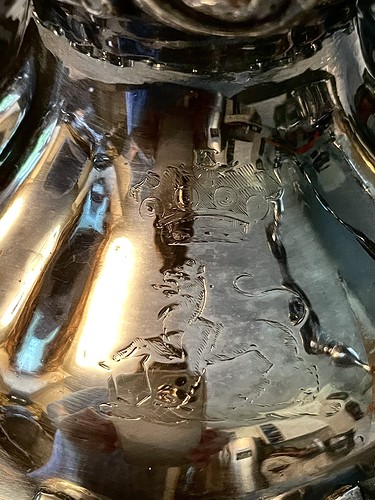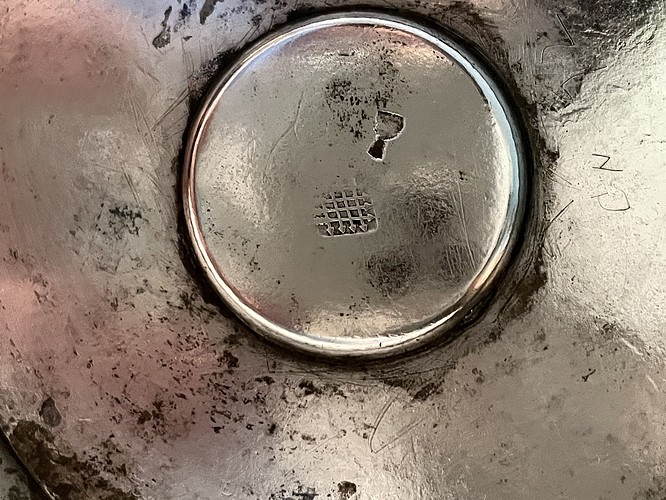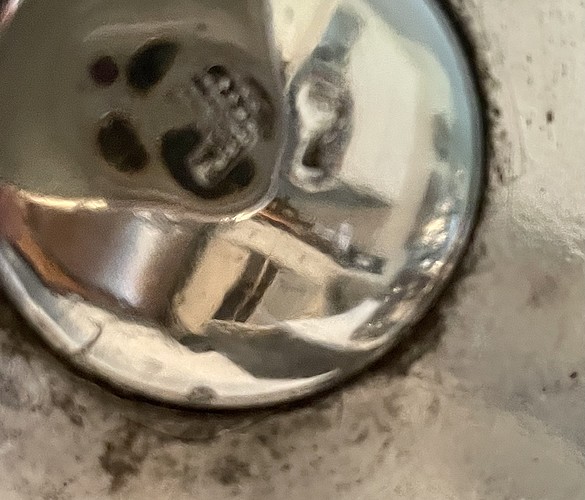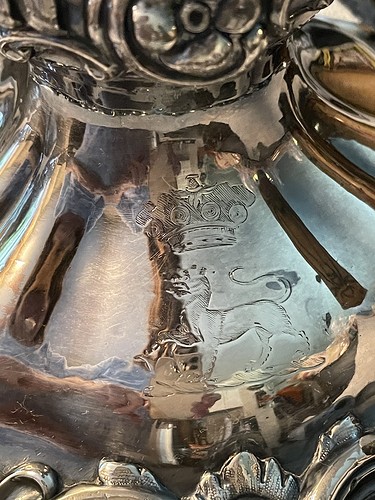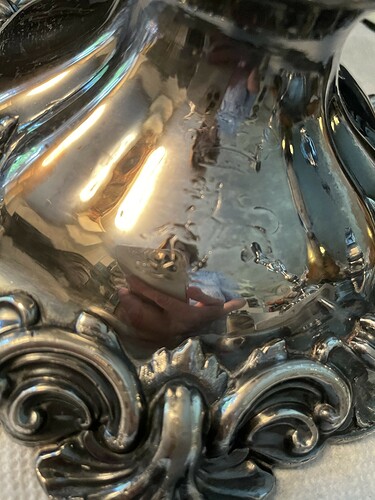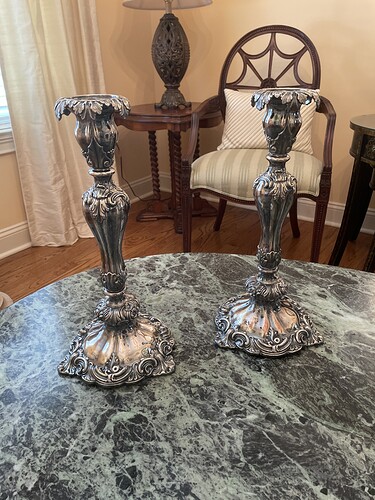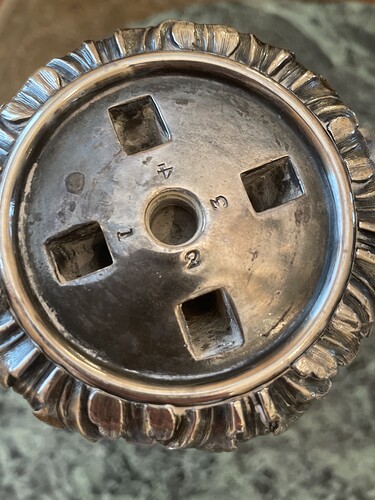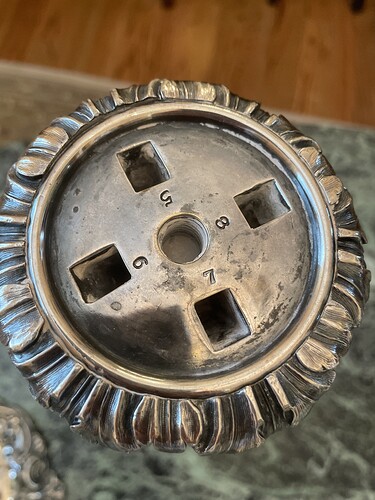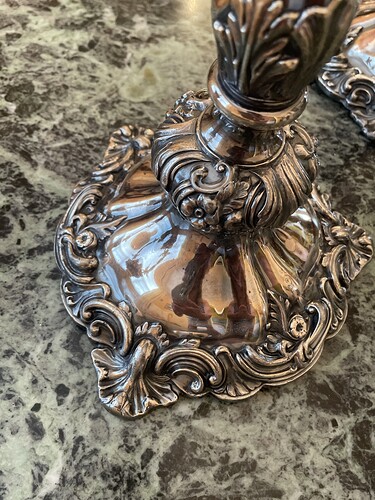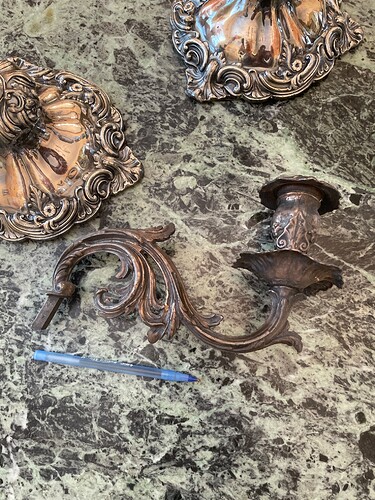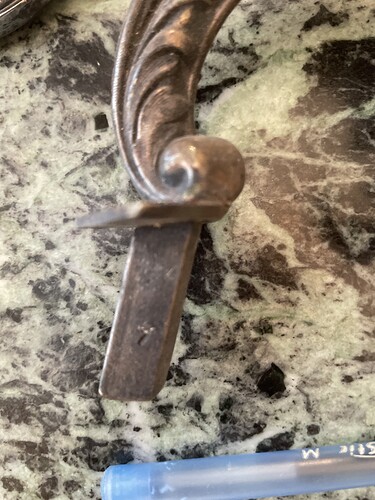The portcullis or gate is almost certainly Arbroath. Andrew Davidson worked there.
https://www.smpub.com/ubb/Forum7/HTML/001167.html
CRWW
In my opinion this is not likely to be Arbroath. Although there is a great deal of variation in marking on Scottish provincial silver this particular version of a “portcullis” is not shown for Arbroath. In fact it is not a portcullis at all - rather 8 crossed arrows. This brings to mind the electroplate mark of William Hutton & Sons of Sheffield. But it’s not that either. I think this is more likely to be from continental Europe. In particular the armorial doesn’t give me the feeling of being British.
Phil
The coronet is a plain silver-gilt circlet, with six pearls of which four are visible. In the UK this is for a Baron or Baroness, but because it is much rubbed even this is a guess.
( Memo to silver cleaners: stop rubbing abrasives on hallmarks and heraldry. A soft toothbrush and a little dab of commercial washing soap will work nicely to get impacted detritus out of the mark)
The depiction under it is of a hound triapante with dog’s head and long curly tail and that is almost always continental, typically either Spanish or southern German. UK dogs are typically smaller – sometimes referred to as Talbot dogs, basically the ancestors of the modern terriers used in the foxhunting business to clear out foxes gone to ground.
I would need to see the item rather than just the marks on it to be certain I agreed with Phil. We are both working on the presumption it is silver either .800 if continental other than French or higher. I do agree it is not the old Creswick mark adopted by Hutton when they took it over as those were on the diagonal not the vertical.
What neither of us addressed was the secondary mark which appears to be a chalice, cup or even a bell. It may be an export mark.
I concede the portcullis is either crossed pikes or arrows – although this is exactly how portcullis ((from old French porte coleice, “sliding gate”) were devised – pointed stakes on a fixed frame which could be lowered on invaders impaling anyone who managed to get under them. Rather unpleasant precursor to the boiling tar which arrived next.
CRWW
Amazing- thank you so much for all your insight. Do you have a thought on the age? Thank you again!
I cannot speak for Phil but I think we need a picture of the entire item. At present, I would guess mid-nineteenth century. Had it been Davidson it was 1825-45 as I recall.
But there a thing about marks that look like assay or makers marks but aren’t quite right and that is that some folks, pandering to the burgeoning desire for antique silver which started in the early to mid-nineteenth century, created marks that looked good enough to fool an amateur like me but wouldn’t get past Phil’s eagle eye. Not saying that is what happened here, but we still haven’t identified the marks. I have eliminated France and Germany and haven’t started on Spain. Why don’t you do Spain yourself and let us know! My Spanish is
only good enough to tell my Mexican staff to do something different but I think, despite your Mr Johnson’s anti-EU efforts, you Brits still spend a lot of time there.
Buena caza,
CRWW
I can not speak a word of Spanish- I greatly appreciate any thoughts you have. I included more pics to Phil- they are quite large- 16” + high, base is approximately 8” across- with one of the arms (approximately 10” long)
Now that we can see more of the candelabra I am beginning to doubt whether they are solid silver. I appreciate that the room setting is giving them a brown colour but there seems to be more of a coppery tinge than I would expect from solid silver. I wonder if we are dealing here with plated metal - or even a white base metal. Absence of a recognised silver fineness marking may be significant.
Phil
Oh I absolutely think this are plated- it appears to be copper beneath- they are very heavy
Well, they are very pretty sticks in the mid to late Victorian floreat style.
So now we have cleared up they are not sterling or even .800 silver so looking for silver marks is rather a blind alley, let’s try and figure out what they are:
The first question is are they Sheffield plate or Electroplated Nickel Silver? Sheffield Plate basically is a rollled sheet of .925 silver soldered onto a sheet of copper sometimes, in the case of later mugs or other containers with another silver sheet inside making a silver sandwich with copper in the middle.
These items called Sheffield silver plate were invented by Thomas Boulsover in the mid-1700s. He was making a repair to a silver object and discovered that silver and copper could transform into a sheet that could be fashioned into objects that look like sterling silver
Sheffield silver plate dxxhibitis strength, durability, and good looks. Antique Sheffield silver plate objects such as snuff boxes, trays, tea sets, coat buttons, candlesticks, patch boxes were once common. Good pieces with top marks by the likes of Matthew Boulton are often today priced higher than plain silver.
If this is what you had you would be able to see the folds on the edges.
So that leaves EPNS; basically, a thin layer of pure silver applied to a previously cast item using a catalytic converter. I would bore you with the science you can look that up yourself (No Spanish required) but it was a system that suited the Victorians seeking to ape their richer, smarter friends in the West End. It’s basically Victorian Bling.
Elkington was the King of Bling, taking plaster casts of all sort of famous silver objects and mass casting them in base metal and then coating them with .999 silver and selling them to the matrons of Ealing. He made a fortune, got to meet the Queen, and annoyed her husband.
EPNS Silver remains popular and allows the silver to be applied to anything which will take a negative electrical charge. Because it is so thin and because people like shiny bling it tends to wear off. A simple solution takes it back to the silversmith and re-bling it.
Anybody else reading this should realize two things, first, you will be charged a fee for the work plus the amount of silver you attach, and second if your item is, in fact, Sheffield Plate not EPNS mass production you will have to ruin a perfectly valuable antique. It will also more or less wipe out the crest and infill the still unidentified marks
Summary: the good news is you have a wonderful ornate mid/late Vicky style pair of candelabra which if they are not plated and you re EPNS them and then fire you cleaning lady will look splendid for another fifty years. The bad news is if you go broke and need to rush off to the pawnshop clutching them to raise the dough to bail your cousin out of the local hoosegow, he is going stay there for a bit.
Not that I am suggesting you have a cousin who would find himself there, but you get the point.
All the best from the Americas
CRWW
Oh you are wonderful! Really enjoyed your response! You hit the mark w the relatives…. My brother sold off all but 2 arms that were solid silver…… I’m sure for melt weight because what else would they use them for? and we no longer speak.
and we no longer speak.
So basically, after all that, what you have is a pair of candelabra bases with an arm each and each missing three more?
If the arms were silver they would have been hall-marked. If Phil is right, and he usually is, continental or .800 silver, and if English .925 silver. But you didn’t show us any silver marks on the two arms remaining so we are presuming they too are EPNS or plate.
If you happened to have a bag or two of plaster of Paris, some bronze ingots, a small blast furnace, a metal file and a plater you could make some new arms.
It would be a complete waste of time from an economic point of view but it would take your mind off your annoying relatives for a week or so.
Failing that, or in the alternative finding some new arms, you have a purely decorative object – which is a polite way of saying completely useless.
When I lived in your country for a month or so they used to have things called jumble sales. I thought it was something to do with elephants – although how they got enough elephants on the vicarage lawn to generate any interest I was a little unclear about.
Anyway, I discovered I was nearly right they didn’t actually sell elephants they sold white elephants – white elephants being things that have little or no intrinsic merit and utterly lack utilitarian value but which, if you happen to be deeply religious you will buy, if only to put back in the same sale the following year. You also get fruit cake. Although how that worked I never asked.
I guess this is recycling in the world of religion. Anyway, that may well be the highest and best use of your impedimenta. And, who knows, your brother may show up and be tempted to buy them for the good of his soul.
Okay, probably not.
CRWW
